The advertising industry is evolving rapidly with advancements in advertisement tech (AdTech). Companies increasingly embrace innovative AdTech solutions to revolutionize their marketing strategies and enhance customer engagement. From programmatic advertising to AI-powered targeting, AdTech trends offer practical ways for businesses to reach their target audiences.
Aloa, a leading software outsourcing expert, assists startups and businesses dive into advertisement tech. With invaluable guidance, we help navigate complexities and challenges, keeping businesses updated on the latest trends for success in the competitive advertising landscape. By staying ahead of trends and providing invaluable support, we ensure your successful and rewarding journey.
In this blog post, we will explore the top advertisement tech trends in 2024. With in-depth analysis, real-world examples, and actionable insights, we offer valuable guidance to assist businesses and startups in thriving in the dynamic realm of advertising technology. We aim to empower you with the knowledge and resources necessary to remain competitive in today's fast-paced market.
Afterward, you'll uncover invaluable insights to excel in the dynamic realm of advertising technology trends. Stay ahead and harness these advancements to leverage innovative solutions and transformative opportunities that propel excellence in advertising and marketing strategies.
Let’s begin!
What is Advertisement Tech?
Advertisement tech encompasses tools and platforms for creating, distributing, and optimizing digital ads, including ad servers, DSPs, SSPs, and RTB systems. It enables precise audience targeting, campaign tracking, and automation, revolutionizing marketing efforts.
AdTech is closely related to marketing technology (MarTech), which involves tools and platforms for managing and optimizing marketing campaigns, customer interactions, and data analysis. As the digital advertising industry expands, AdTech becomes essential for advertisers, publishers, and marketers to enhance their strategies and navigate the online marketplace effectively.
Top 7 Trends in Advertisement Tech to Follow in 2024
Staying ahead in advertisement tech is crucial for achieving better results in marketing campaigns. In 2024, the advertising sector is set for significant breakthroughs in technology. Let's explore the major trends and changes expected to transform advertisement technology this year.
Trend 1: AI-Driven Personalization
AdTech platforms will increasingly leverage artificial intelligence (AI) and machine learning algorithms to deliver highly personalized advertising experiences. These systems will analyze vast amounts of data to understand consumer preferences and behavior, enabling advertisers to tailor their messages more effectively.
Forbes Advisor research shows businesses anticipate a 64% productivity boost from AI. This drives advertisers to use AI for streamlined processes, targeted ads, and optimized campaigns. Despite consumer concerns, trust is built through transparent AI practices, AI-generated content, and adapting to voice search trends, acknowledging AI's role in effective marketing.
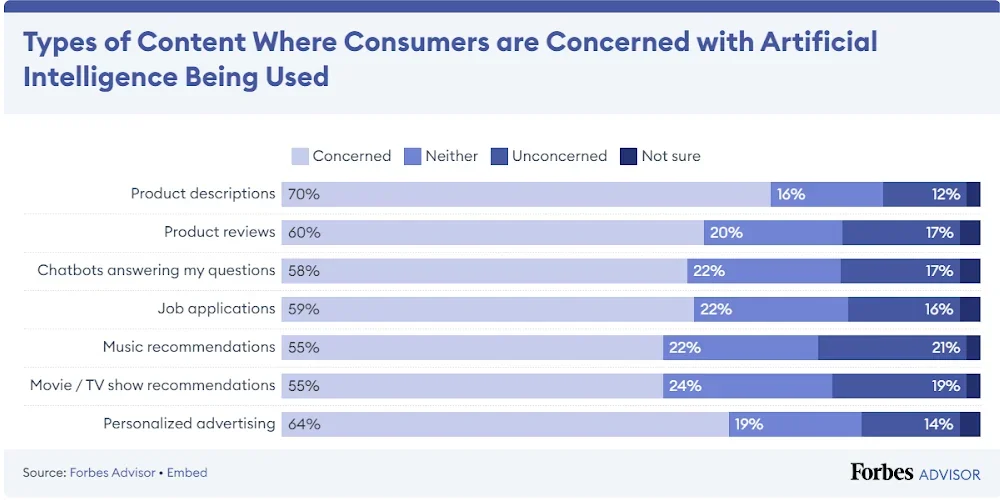
Why AI-Driven Personalization Will Impact the Industry
AI-driven personalization is revolutionizing the industry by tailoring experiences to individual preferences at scale. Through advanced algorithms that analyze vast datasets, businesses can deliver relevant content and recommendations, enhancing customer engagement and boosting conversion rates.
Additionally, AI-driven personalization optimizes digital marketing efforts and maximizes ROI. Companies can effectively segment their audience, target specific demographics, and craft compelling messaging by leveraging AI insights. This customization enhances campaign efficiency, helping to achieve higher conversion rates.
Trend 2: Programmatic Advertising
Programmatic advertising automates the buying and selling of digital ad inventory in real time through algorithms and platforms. It enables precise audience targeting using data-driven insights, improving efficiency and campaign performance. This transformative approach revolutionizes digital ad campaigns by optimizing the entire process for better results.
Statista reported that global spending on programmatic advertising soared to an estimated $558 billion in 2023, poised to exceed $700 billion by 2026. While the United States continues to lead the global market, countries like China and the United Kingdom increasingly embrace the advantages of programmatic buying.
.webp)
Why Programmatic Advertising Will Impact the Industry
Programmatic advertising revolutionizes the industry by automating the buying and selling of ad inventory across digital platforms. This approach leverages data-driven algorithms to target audiences more effectively and efficiently than traditional methods.
With its ability to optimize online advertising campaigns in real-time and reach consumers across multiple channels, programmatic advertising offers advertisers greater flexibility, transparency, and scalability in reaching their target audiences, thus reshaping the dynamics of the advertising ecosystem.
Trend 3: Rise in Video Advertisements
The AdTech industry sees a surge in video ads, driven by evolving consumer preferences and tech advancements. Video ads provide immersive experiences, capturing attention more effectively than traditional displays. With video streaming, social media, and mobile use on the rise, advertisers use videos for compelling storytelling. To meet the demand for captivating video content, advertisers are increasingly turning to the best AI video generators, which efficiently produce high-quality videos at scale, enhancing engagement and ROI.
As of Wyzowl’s data tracking since 2016, the utilization of video as a marketing tool has remained at an all-time high, with 91% of businesses incorporating it into their strategies in 2024. This suggests that video marketing remains a crucial strategy for businesses, and its importance will likely persist in the coming years.
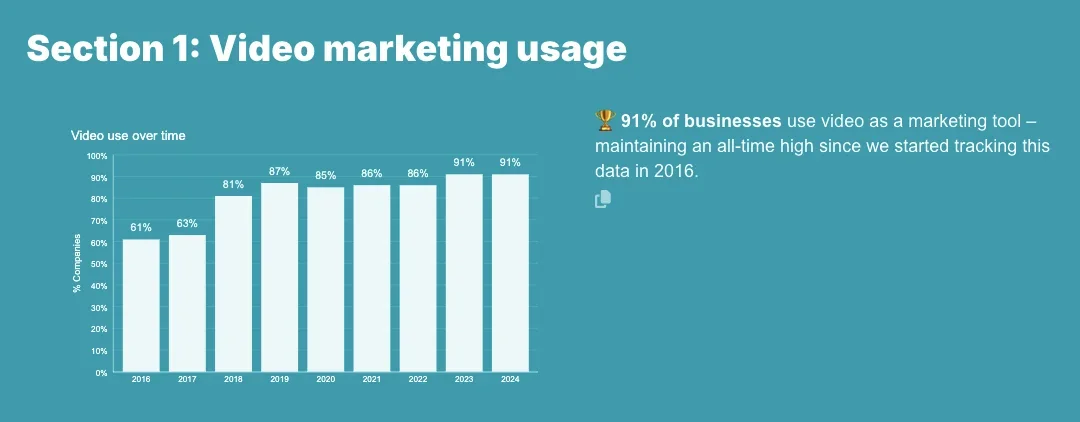
Why Video Ads Will Impact the Industry
Video ads will significantly impact the AdTech industry by offering immersive experiences and effectively capturing audience attention. With the rise of video streaming platforms, social media, and mobile devices, advertisers increasingly leverage video ads for compelling storytelling and brand messages.
Additionally, video ads have the potential to enhance brand recall and engagement due to their dynamic and visually appealing nature. They allow advertisers to convey complex ideas and emotions concisely and effectively, fostering deeper connections with their target audience. However, if you're new to the market and are struggling to do all this on your own consider working with a video production startup to help you in the world of visual content.
Trend 4: TikTok Ads Relevance
TikTok ads are trending in AdTech. With its growing user base and engaging short-form videos, TikTok is lucrative for brands targeting younger demographics. Advertisers use TikTok's innovative ad formats, like in-feed ads and influencer partnerships, for authentic brand experiences.
Based on eMarketer’s recent data, TikTok's ad revenues are projected to reach $17.2 billion in 2024, a 30.7% increase from the previous year. TikTok is the social network where consumers spend the most time and ranks among the fastest-growing social media platforms.
.webp)
Why TikTok Ads Will Impact the Industry
TikTok ads are poised to impact the AdTech industry significantly due to the platform's immense popularity, especially among younger demographics. With its short-form, engaging content and extensive reach, TikTok offers advertisers a unique opportunity to connect with a highly engaged audience.
Moreover, TikTok's advanced targeting capabilities and data analytics empower advertisers to customize their mobile ad campaigns using audience data, catering to specific demographics, interests, and behaviors. This level of precision targeting ensures that ads reach the right audience at the right time, maximizing engagement and conversion rates.
Trend 5: Omni-channel Marketing
Omni-channel marketing in AdTech combines various channels for consistent brand experiences. Advertisers recognize the value of reaching consumers through social media, email, search engines, mobile apps, and physical stores, allowing platforms to engage audiences effectively, understand preferences, and deliver personalized messages.
According to GrandView Research, the global omni-channel retail solutions market was valued at USD 5.96 billion in 2021 and is expected to grow at a CAGR of 13.6% from 2022 to 2030. Omni-channel retail integrates digital and physical channels, creating seamless customer shopping experiences by blending online and in-store channels.
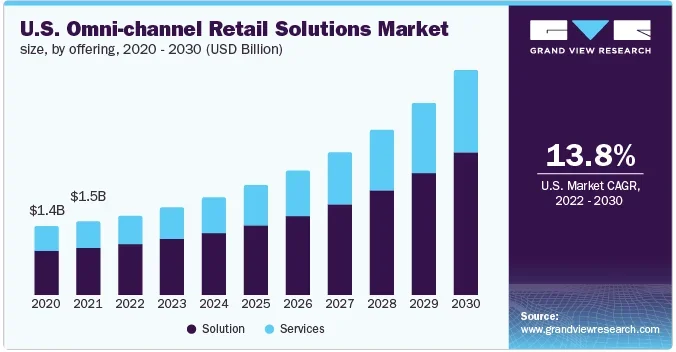
Why Omni-Channel Marketing Will Impact the Industry
Omni-channel marketing is poised to significantly impact the industry by revolutionizing how brands engage with consumers across various touchpoints. This approach emphasizes seamless integration and consistency across multiple channels, including online platforms, social media, physical stores, and mobile apps.
Moreover, omni-channel marketing enables brands to gain valuable insights into consumer behavior and preferences through data analytics and tracking. By understanding customer interactions across different channels, businesses can tailor their marketing efforts more effectively, delivering relevant content and offers at the right time and place.
Trend 6: Contextual Targeting Evolution
Contextual Targeting in AdTech places ads based on content context, not just user data. This method matches ads with relevant content, like articles or videos, increasing engagement and effectiveness. Ad platforms analyze keywords to align ads with user interests, enhancing campaign performance.
Based on IAB's findings, 74% of marketers are now utilizing contextual data to enhance their advertising strategies, especially after the demise of device IDs and third-party cookies on the web. Interestingly, this percentage surpasses those relying on first-party data (60%) and those outsourcing targeting to publishers' platforms (45%).
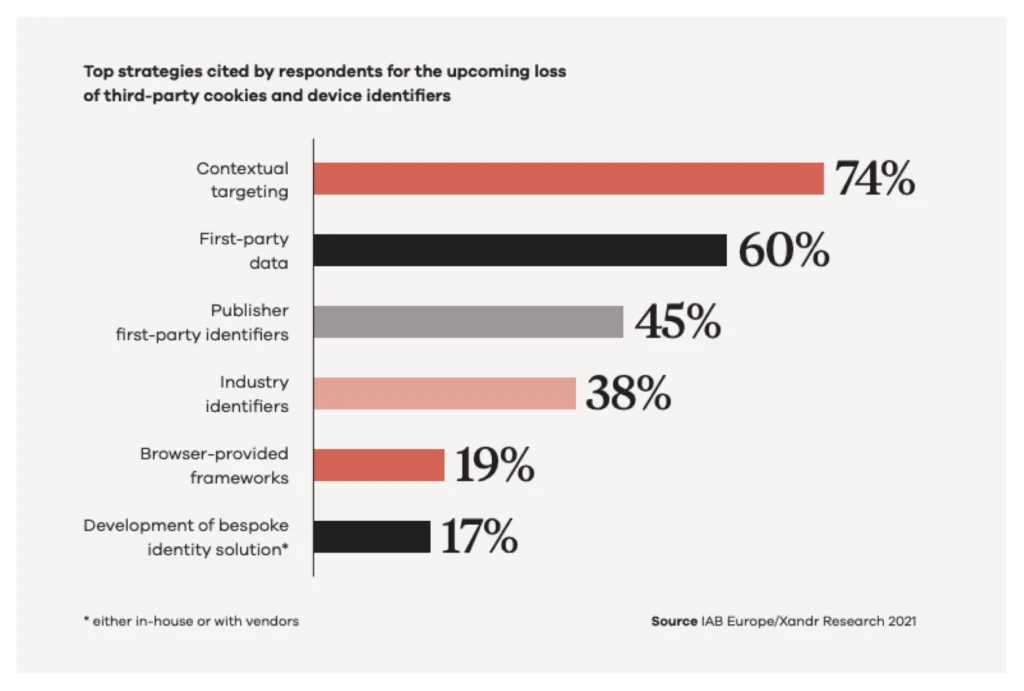
Why Contextual Targeting Will Impact the Industry
Contextual Targeting is poised to impact the industry by offering advertisers a more precise way to connect with their target audience. It enhances relevance and resonance by aligning ads with users' content rather than solely relying on demographic or behavioral data.
Furthermore, contextual targeting allows ad platforms to adapt to changing consumer preferences and content trends in real time. These platforms can continuously refine ad placements by analyzing keywords and topics to match evolving user interests and intent. The ability of AI ads makes this process even more efficient, helping brands design personalized ads at scale.
Trend 7: Chatbot and Conversational AI Advancements
Chatbots and conversational AI are gaining traction in AdTech as brands seek innovative ways to engage with consumers and streamline interactions. Integrating these technologies into AdTech strategies enhances customer satisfaction, boosts lead generation, and drives conversions through efficient and scalable automated channels.
According to Statista, in 2022, the global chatbot market hit $4.7 billion and is expected to grow by 23.3% annually from 2023 to 2028, reaching $15.5 billion. In-house bot solutions dominated the market with a 62.0% share, while sales and marketing activities drove user engagement, representing 39.5% of the market.

Why Chatbots and Conversational AI Will Impact the Industry
Chatbots and conversational AI revolutionize customer engagement for businesses. They provide personalized experiences, delivering targeted messages and assistance in real time. Automating support and guiding sales processes seamlessly enhances customer satisfaction, streamlines interactions, and drives business growth.
Moreover, chatbots and conversational AI present opportunities for businesses to improve operational efficiency and scalability. By automating repetitive tasks and providing round-the-clock support, these technologies reduce the burden on human resources and enable companies to handle increasing customer inquiries effectively.
How to Stay Ahead of the Curve in Trends in Advertisement Tech
To make the most of the latest advancements in advertising technology (AdTech), it's crucial to grasp emerging technologies and trends while embracing a forward-thinking approach. Here are some tips to help you stay ahead of the curve and achieve positive outcomes in advertisement technology:
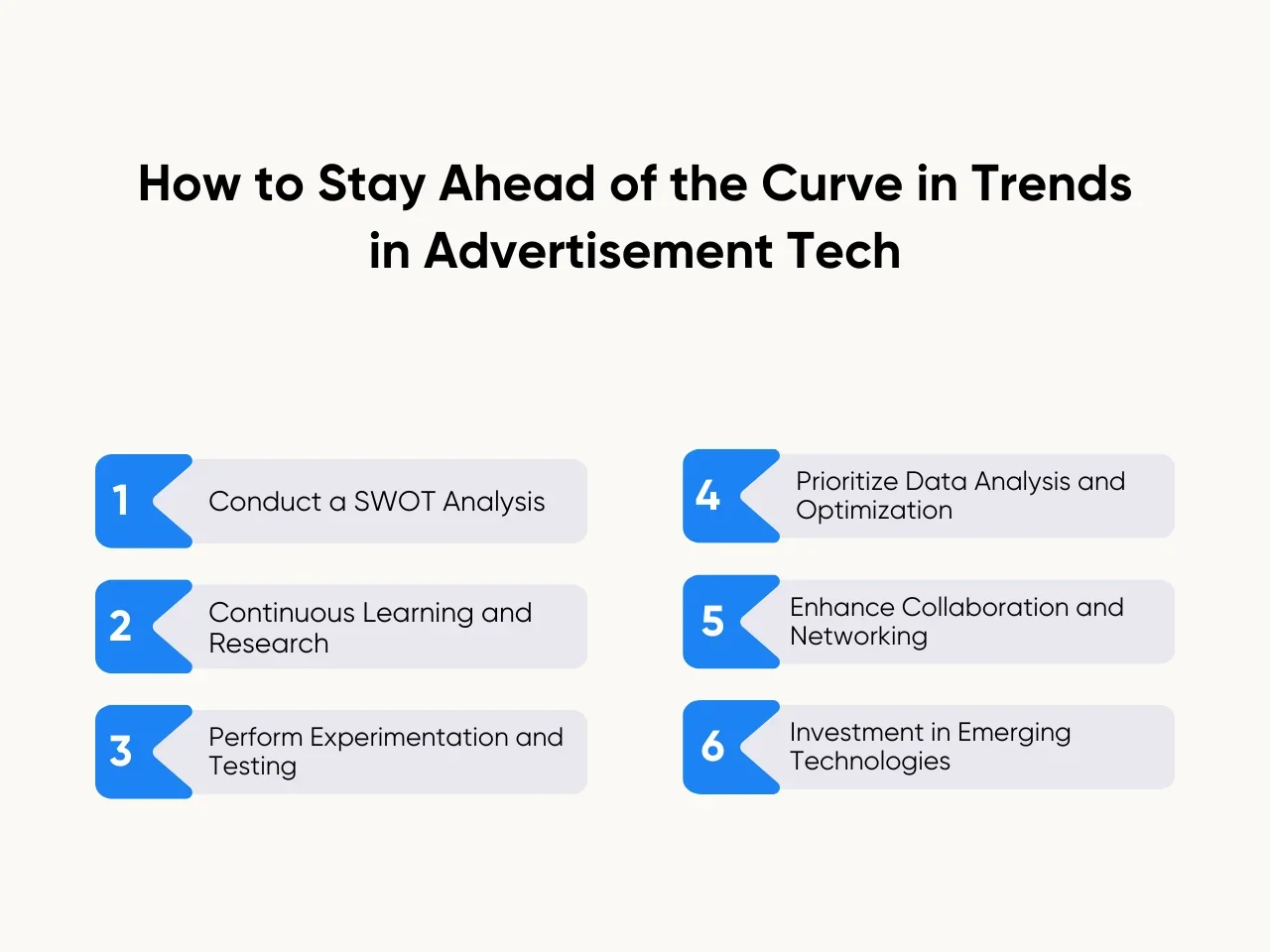
Conduct a SWOT Analysis
Analyzing advertisement tech helps identify strengths, weaknesses, opportunities, and threats. It uncovers trends and growth areas, enabling the development of strategies to stay competitive. Regular SWOT analyses are crucial for keeping up with industry changes and informing decision-making.
Additionally, stakeholders can glean valuable insights into the strengths, weaknesses, opportunities, and threats linked to advertising technology. When conducting a SWOT analysis for analyzing advertisement technology, several factors should be considered, including:
- Technological Advancements: Assess the state-of-the-art technology used in advertisements and its effectiveness.
- Targeting Capabilities: Evaluate the ability to target specific demographics or audiences accurately.
- Technical Limitations: Identify any shortcomings or limitations in the technology infrastructure.
- Integration Challenges: Evaluate the ease of integrating advertisement technology with existing systems or platforms.
- Market Expansion: Identify emerging markets or segments where advertisement technology can be leveraged.
- Innovation Potential: Explore opportunities for innovation and develop new features or services.
- Competitive Landscape: Analyze the competitive landscape and potential threats rival advertisement technology providers pose.
- Regulatory Changes: Consider the impact of evolving regulations and compliance requirements on advertisement practices.
- Utilization of Agency Trading Desks and AI: Employ agency trading desks and AI for efficient and data-driven ad placements across various platforms such as search engines, Google Marketing Platform, Facebook, TV, and more.
Continuous Learning and Research
Staying up-to-date with the latest trends is vital for professionals. To achieve this, watching industry news and attending relevant events that can provide valuable insights is essential. Subscribing to publications and following thought leaders on social media can also help gain knowledge.
Moreover, learning from past successes and failures, experimenting with new AdTech software and technologies, and optimizing email marketing strategies offer practical experience. By staying informed and adaptable, professionals can remain competitive and prepare for future challenges.
Perform Experimentation and Testing
To stay ahead in advertising tech, businesses must experiment and test different strategies. This helps them identify successful approaches, eliminate inefficiencies, and gain a competitive advantage. A/B testing allows for comparative analysis of ads or platforms while experimenting relies on AI or VR, which can provide an edge.
Furthermore, businesses can effectively experiment and test different approaches in digital advertising technology, leading to improved performance and enhanced customer engagement. Here are some critical strategies that you should consider for experimentation and testing in advertising technology:
- A/B Testing: Conduct comparative analysis by testing variations of ads, messaging, or platforms to determine which elements resonate best with the target audience. This method helps in optimizing campaigns for maximum effectiveness.
- Utilizing AI and VR: Explore the potential of Artificial Intelligence (AI) and Virtual Reality (VR) technologies to enhance advertising experiences. Experimenting with AI-driven targeting algorithms or immersive VR advertisements can differentiate your brand and capture audience attention innovatively.
- Data-Driven Decision-Making: Leverage data analytics and insights from experimentation to inform decision-making processes. Analyze metrics such as click-through rates, conversion rates, and audience engagement levels to refine advertising strategies and allocate resources effectively.
Prioritize Data Analysis and Optimization
Data analysis is the foundation of ad performance, identifying patterns and trends that drive results. On the other hand, optimization plays a critical role in maximizing ad campaign effectiveness and boosting ROI. A/B testing is the key for refining targeting and messaging to achieve better results.
Moreover, monitoring metrics like click-through rates, conversion rates, and cost per acquisition is crucial for adjusting approaches, targeting the right audience, and allocating resources effectively. Leveraging customer data enhances personalized targeting and improves overall advertising strategy.
Enhance Collaboration and Networking
Collaboration and networking are crucial for staying updated on advertising tech trends. Attend industry events and conferences to connect with peers and learn about new technologies. Engage in online communities and forums to network with professionals. Collaborate with vendors, agencies, and partners to share knowledge and stay current.
In addition, networking creates partnership opportunities to benefit both parties involved, whether at industry events or online platforms. Here are some critical aspects of collaboration and networking in digital advertising technology:
- Industry Events and Conferences: Industry events and conferences provide networking and insights into advertising trends. Attendees exchange ideas with peers and experts to stay updated.
- Online Communities and Forums: Engaging in online ad tech communities connects professionals, fosters advice-sharing, and keeps them informed on industry trends.
- Partnerships and Collaborations: Collaborating with vendors, agencies, and industry peers fosters mutual learning and cooperation. By sharing knowledge and resources, organizations can innovate in advertising technology.
- Knowledge-sharing initiatives: Promote knowledge-sharing within teams and organizations for ongoing learning and development. Workshops, seminars, and webinars offer chances to discuss trends and gain skills in advertising technology.
Investment in Emerging Technologies
Investing in emerging technologies like AI, AR/VR, and voice-activated ads can propel businesses in advertising trends. These technologies enhance ad relevance, create immersive experiences, and address the expanding user base of voice assistants. Embracing emerging tech trends can revolutionize advertising strategies, keeping businesses competitive.
That being said, businesses can adjust to changing consumer preferences, set their brand apart, and stay ahead in advertising innovation through investing in these technologies. Some emerging technologies worth investing in for advertisement tech include:
- Artificial Intelligence (AI): AI-driven advertising technologies enable businesses to analyze vast data, personalize ad content, and optimize targeting strategies. AI-powered algorithms can enhance ad relevance, improve digital advertising campaign performance, and drive higher engagement rates.
- Augmented Reality (AR) and Virtual Reality (VR): AR and VR technologies offer immersive advertising experiences that captivate audiences and drive brand engagement.
- Voice-Activated Ads: With the growing popularity of voice assistants like Amazon Alexa and Google Assistant, voice-activated ads represent a promising avenue for advertising innovation.
- Blockchain Technology: Blockchain technology offers advertising transactions transparency, security, and accountability. Using blockchain-based platforms, advertisers can prevent ad fraud, verify ad delivery, and establish trust between advertisers, publishers, and consumers.
- Programmatic Advertising: These technologies automate buying and selling ad inventory, enabling real-time bidding and targeted ad placements.
- 5G Technology: The rollout of 5G networks promises faster internet speeds, lower latency, and enhanced connectivity, which can revolutionize how ads are delivered and consumed.
- Data Analytics and Predictive Modeling: Advanced data analytics and predictive modeling tools empower advertisers to gain deeper insights into consumer behavior, anticipate market trends, and optimize ad targeting strategies.
Key Takeaway
Embracing the evolving trends in advertisement tech is crucial in today's dynamic digital landscape. Businesses are encouraged to integrate and capitalize on the potential of emerging Ad Tech solutions. These advancements optimize marketing strategies, improve campaign management, and enable better targeting through enhanced data analytics, ultimately revolutionizing the effectiveness and reach of advertising efforts.
Leveraging these AdTech innovations requires collaboration between marketing professionals and technology experts. This collaboration redefines marketing approaches, enhances customer engagement, and drives business growth. However, prioritizing data privacy, regulatory compliance, and seamless platform integration is essential to navigate the intricacies of advertisement tech.
Sign up for our email list through the Aloa blog page to stay updated with the latest developments in the AdTech industry. We'll share relevant topics as they unfold, helping you stay ahead of market trends and apply them to your marketing efforts in 2024!

